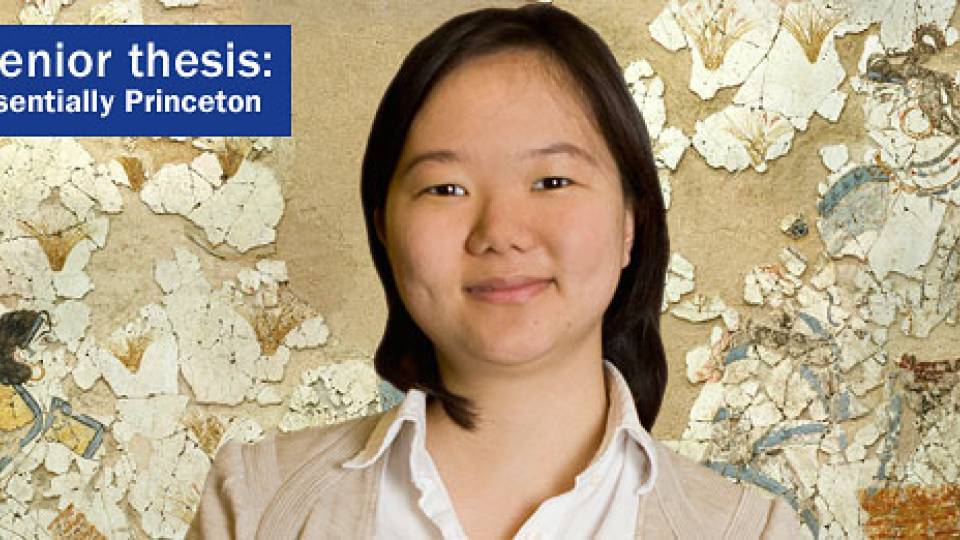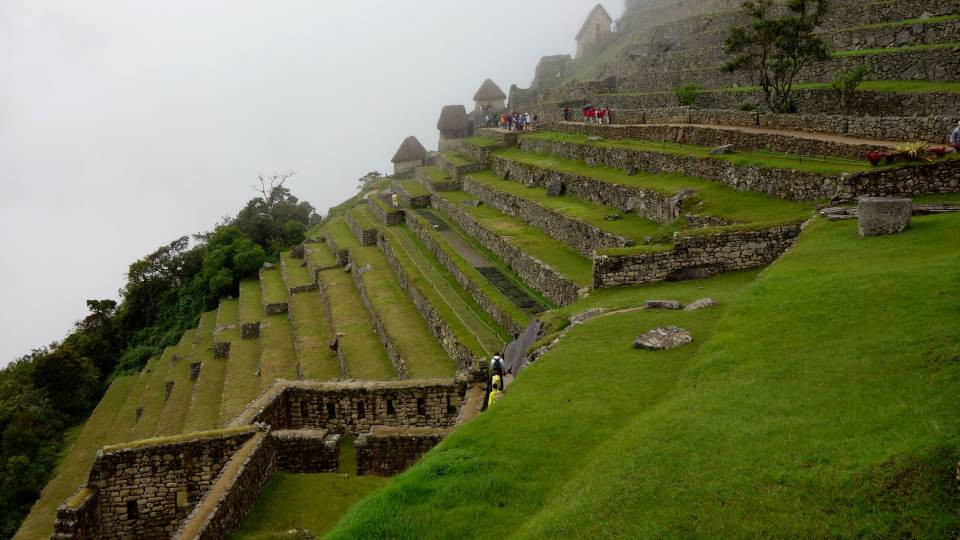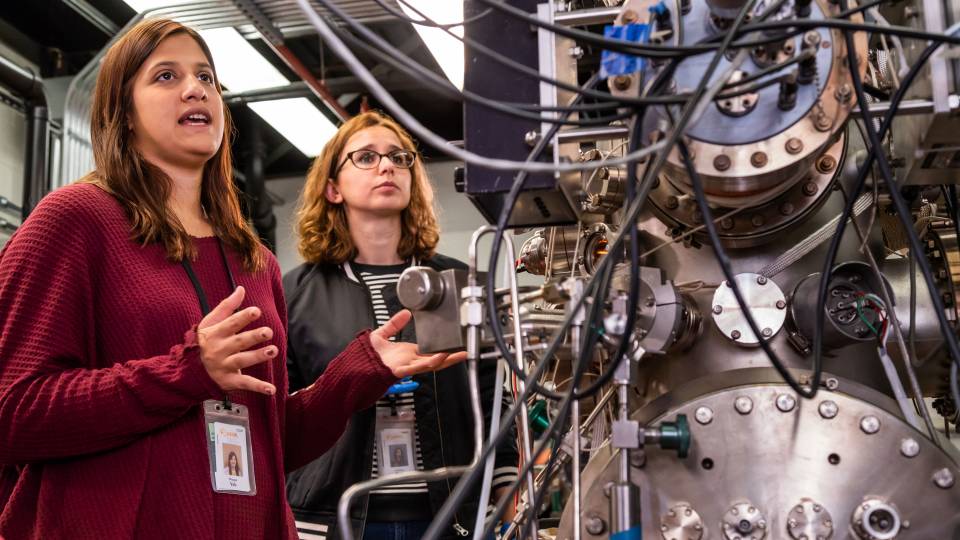George Scherer, professor of civil and environmental engineering, does not see the Princeton campus as others do.
Among the meticulously maintained buildings and the treasured stone carvings, Scherer's eye seeks out the problems, the flaking stone here, the eroded inscription there.
"This is a lovely example of salt deterioration," Scherer said as he led a group of undergraduates past Firestone Library during a recent tour of campus.
His enthusiasm for spotting and diagnosing problems is infectious, and is at the heart of a new teaching and research program he is developing. After spending most of his career as a materials scientist at Dupont and Corning research labs, Scherer came to Princeton in 1996 and turned his expertise to the conservation of art, with a specialty in stone buildings and monuments.
Scherer's research program already is producing insights into the ways stones deteriorate as well as into materials that soak into stones to prevent and repair some types of damage. One such material developed by Scherer may soon be tested on crumbling walls around the ancient Greek city of Rhodes.
Scherer also introduced a new course this year on conservation of art. Although it is a lab-based course in materials science, the class is geared toward non-science majors. It already has proven popular, with all 35 slots filled.
For both his teaching and research, the Princeton campus, with its rich variety of stonework, is the perfect laboratory. Scherer works closely with staff in the facilities department to develop strategies for protecting and repairing buildings.
His recent campus tour was the first lab session of his art conservation class, and an opportunity for Scherer to introduce his students to some of the subtle and not-so-subtle ways that seemingly impervious stone can succumb to the elements.
Stopping to look at a monument between the Chapel and McCosh Hall, Scherer pointed out that frost and acid rain had worn nearly all the inscriptions from the 80-year-old obelisk. In the courtyard between the Pyne Hall archways, he noted a single carved medallion that was almost completely obliterated while those next to it were unharmed, the result, he believes, of the peculiar way rainwater runs down that wall.
His conclusion was not just idle speculation. "I stood here in the rain one day and watched where the water was running," he said, "which is something you do quite a bit in this business."
Each stop on his tour was its own small mystery, with Scherer nudging the students to make deductions about the evidence before them, like Sherlock Holmes to a class of Dr. Watsons. When the answers were not clear, he assured the class he would get back to them with the latest results from his lab.
Scherer's emphasis on sleuthing out true causes and effects of damage is central to his research as well as his teaching. "If you want to make a proper repair, first you need a good diagnosis," he told the class.
"Just as in medicine, you need to diagnose the problem before you treat it."
Unfortunately, noted Scherer, there is too little of this kind of analysis in the conservation business. His research program is unique in that he is focused on studying the underlying principles of stone conservation, rather than developing immediate solutions to pressing problems.
Traditional funders of science, such as the National Science Foundation, have almost no grant opportunities for basic research in art conservation, said Scherer. As a result, conservation scientists often have to use ideas and techniques handed down over generations, rather than developing solutions based on rigorous analysis. And any time or money that might be spent on basic research is often pressed into service to solve immediate problems.
"There's a lot of Band-Aid work in this field," agreed George Wheeler, a research chemist at the Metropolitan Museum of Art. "George's research is really quite high level and cutting edge. He is taking a fresh look at some fundamental problems we've had for a long time."
Scherer credits Wheeler with sparking his interest in the field 15 years ago when the two met at a scientific conference. Scherer was studying inorganic gels that have a wide variety of potential applications from optoelectronics to transparent thermal insulation.
Wheeler was interested in the same materials for a use Scherer had never heard of -- protecting porous stones from damage by salt crystals. After keeping up an association over the years, Scherer has now used similar materials to develop the protective products that he hopes to test in Greece.
Saltwater damages stone when it seeps into the pores, then dries and leaves crystals, said Scherer. As the crystals grow, they develop an electrostatic repulsion with the stone around them, and this repulsion exerts pressure that can break the stone. The material Scherer developed coats the insides of the pores and makes it compatible with salt, so the crystals simply fill up the space and stop growing.
Using samples of limestone, Scherer and students in his lab compared the effects of salt on treated and untreated stones. After six cycles of soaking and drying, the untreated stone was badly damaged, but the treated one was mostly unharmed.
Another material, which Scherer is testing on samples sent to him by Greek conservationists who are working on the ancient wall of Rhodes, would strengthen already damaged stone.
The Greek conservators are "very interested in having some of our materials to paint on the wall," Scherer said. "We're just very conservative. We want to make sure we've done it right."
One challenge, he said, is to make sure that the proposed solution does not do more harm than good. "You always worry about doing something subtle, but pathological, that may show up 10 years down the road," he said. One way to avoid such problems would be to simulate the repair and subsequent aging process in the laboratory. But there are no clear methods for accelerating 10 or 100 years of aging.
Such questions underscore the need for basic research in the field, he said. Scherer credits Princeton with giving him the freedom to pursue such work, and is looking for creative ways to fund it. He has hired one postdoctoral scholar, Robert Flatt, who developed an expertise in ancient mortars at the Ecole Polytechnique of Lausanne, Switzerland. The rest of his research help comes from undergraduates, who have helped test and develop the new materials for senior theses and summer work projects.
So far that arrangement has worked well, because the students have been enthusiastic about experimenting with real stones from antiquity. In one project this semester, students from his class are helping conservators at the University Art Museum to catalog ancient Egyptian stones that recently began to deteriorate rapidly and lose their hieroglyphics. Scherer, meanwhile, will try to decipher the cause of the damage.
This interplay between research and teaching opportunities is ideal, Scherer said. "These are beautiful problems in materials science, and it seems to me to be a perfect vehicle for teaching undergraduates about the field."
Contact: Justin Harmon (609) 258-3601





